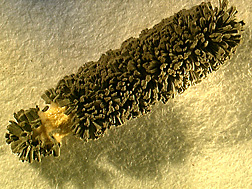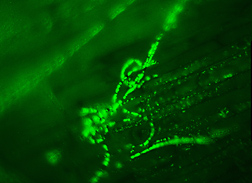This page has been archived and is being provided for reference purposes only. The page is no longer being updated, and therefore, links on the page may be invalid.
Read the magazine story to find out more. |
|
Friendly Fungus Could Help Sugar Beet Fields Go "Green"
By Erin PeabodySeptember 19, 2006
How sweet it is! Scientists with the Agricultural Research Service in Sidney, Mont., may have found a natural alternative to the copious pesticides that sugar beet growers must spray on fields to fend off their biggest enemy: the sugar beet root maggot.
Stefan Jaronski, an insect pathologist who works at the ARS Northern Plains Agricultural Research Laboratory in Sidney, has discovered that a strain of the biocontrol fungus Metarhizium anisopliae is not only effective at killing the maggot, but is also a vigorous colonizer that can adapt quickly to its new environment. Jaronski's research builds on initial biocontrol efforts by ARS scientists at Fargo, N.D., during the 1990s.
Even though the fungus is a newcomer to sugar beet soils, it's quite capable of holding its own among the hundreds of other microbes already established there.
The maggot is certainly worthy of a unique control strategy. This subterranean pest gnaws on young sugar beet roots, inflicting deep wounds that leave the plants vulnerable to disease. It's these destructive feeding habits that make the maggot the most important insect pest on the 1.4 million acres of sugar beets grown in the western United States.
Right now, unfortunately, the only tools available to growers battling it are chemical sprays, such as terbufos, phorate and chlorpyrifos. Without them, farmers in some beet-growing regions—like the Red River Valley of North Dakota—would lose up to 40 percent of their beet crop.
Jaronski, who's been studying biocontrol microbes for more than 25 years, puts a lot of stock in Metarhizium. He considers them the fatal "athlete's foot" of insects, since the fungus first penetrates a vulnerable insect's cuticle, or "skin," using just a few spores. After that, it grows steadily inside the insect until finally overwhelming the host's entire body. Jaronski's next step is to develop an optimal delivery system for the fungus.
Read more about the research in the September 2006 issue of Agricultural Research magazine.
ARS is the U.S. Department of Agriculture's chief scientific research agency.


